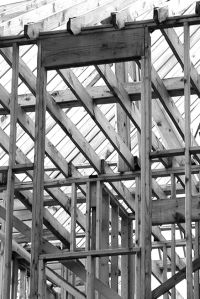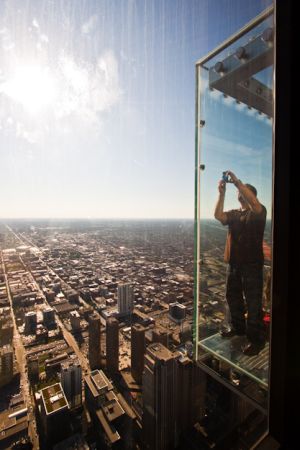
America enjoyed a period much like the High Renaissance in the mid-to-late 19th century. That was our own time of freedom and material well-being. It was a “we-can-do-anything” mood, and it was particularly strong in Chicago.
The city began redirecting American architecture while our buildings were still pretty derivative. Colonial architecture had its own unique flavor, but it was an adaptation of European styles. Two things would ultimately make building different here: One was an abundance of wood, the other, a lack of skilled artisans.

19th Century Iron Facade Structures in Soho, New York
We had to be Jacks-of-all-trades here. European houses used masonry, cut stone, heavy timbers, accurately dovetailed joints ... All that was labor intensive and it took expert carpenters.
First we tried to copy stone with wood. We made imitation columns, cornices, and mantels from wood. We even made chimneys of wood daubed with clay. We used wood at a rate that was impossible in deforested Europe. That meant we also needed nails. So we invented automated nail-making. In the early 19th century, we were making nails for less than the tax alone on European nails.
Chicago was then growing like a weed. In 1833 Augustine Taylor built St. Mary's church in nearby Fort Dearborn. He managed to put up that 36 by 24-foot church for a mere $400, using do-it-yourself carpenters. He eliminated the old mortised beams and fittings -- replaced them with light 2x4s and 2x6s set close together. He used studs and cross-members and held the whole thing together with nails -- no joints. Some swore it would blow away in a high wind. But it did not.

Balloon Construction
So the first baptism at St. Mary's was already disturbed by the sound of hammering next door. Taylor's idea (if it really was his) had caught on. Old-timers called it "balloon construction." Still, if these buildings seemed insubstantial as balloons, they had the light flexible toughness of woven baskets.
They embodied a wholly new structural concept: that a building’s members should absorb its loads in both tension and compression. Wood allowed that; stone did not. With stresses distributed through all parts, far less material still gave the strength of a heavier older building.
Of course, we build our houses today with variants on that same balloon frame. This was a unique American reply to wholly new circumstances. It swept America. And Chicago’s bourgeoning architectural energy had first asserted itself.
Next came the railroads, and Chicago became their great hub. The city grew, through the Civil War, to almost a half million by 1871. Then the Great Chicago Fire wiped out 34 square blocks, destroyed 18,000 buildings, and killed 300 people. Yet the city’s forward movement barely faltered.

The 'Gingerbread' Style
But it did change course: The Chicago of 1871 had become an American architectural showcase. It boasted a dizzying variety of elegant churches. Its balloon frames billowed into huge exquisite gingerbread houses. Of course, all that wood had left the city vulnerable to fire.
Another new architectural form, the iron façade, had also arisen before the Civil War and it found fertile ground in Chicago. The iron façade was a structural exoskeleton that gave strength to the lower floors of a building, yet left room for wide windows. They let buildings begin reaching upward. We still see surviving iron façades in places like Soho New York, and historic Galveston.
In any case, the commerce that had built Chicago was hardly dented by the Fire. Commercial interests demanded that the inner city be rebuilt -- as a fireproof city, an iron city, a city that would make the best use of space in Chicago's crowded downtown. Of course, iron façades had not protected their buildings wooden interiors from fire. Something else was needed.
Two factions converged on the rubble: One was the freewheeling builders of old Chicago. The other was a new breed of designers who’d studied analytical mechanics, and were influenced by France's theoretical École Polytechnique. Out of that stew of new and old, emerged a bold new concept for making tall buildings.
They would now build frames, not of wood but of steel, then hang light stone façades upon them. These new buildings could go to almost any height. They were limited not by structure but by the height an elevator could carry its occupants.
Hydraulic lifts had been around since the 1830s, but they couldn't go very high. Elisha Otis invented a safe steam-powered elevator in 1857, but someone had to keep stoking a fire under its boiler. Electric motors would be the answer. They were first used to drive elevators in Germany, in 1880.
Practical control systems finally made electric elevators effective in the early 1890s. By the turn of the century, tall buildings were typically fifteen stories high. A scant 30 years later, the Empire State Building reached seven times that height.

Chicago in 2010
So the Skyscraper was the phoenix that rose from the ashes of the Chicago Fire. And it all went back to that counter-intuitive concept of distributed forces -- a light frame that absorbed load in both tension and compression, a buoyant idea, the lightness of being born of the lightness of freedom. These real structures were shadows of structures forged in a new state of mind.
Finally Chicago claimed the 1893 World’s Fair. The dazzling Columbian Exhibition turned out to be curiously retro -- white stone buildings, all done in a classical style. Yet the Fair’s grand centerpiece was the most amazing product of buoyant structural imagination yet. It was George Ferris’s great Ferris Wheel, not to be surpassed until London built its London Eye a century later.
Well, while we’re on the subject of lightness and buoyancy, Roger Kaza would like to take us next to the ultimate in weightless structures. And that is the gossamer structure of music.
Sources:
W. Field, A Re-examination into the Invention of the Balloon Frame. Journal of the American Society of Architectural Historians, Vol. 2, Nos. 1-4, Jan-Oct., 1942, pp. 3-29.
G. E. Woodward, Woodward's Country Homes. (New York: Geo. E. Woodward, 1865).
F. W. Peterson, Homes in the Heartland: Balloon Frame Farmhouses of the Upper Midwest, 1850-1920. (Lawrence, KA: University of Kansas Press, 1992).
P. E. Sprague, Chicago Balloon Frame. The Technology of Historic American Buildings (H.W., Jandl, ed.). Washington, DC: Foundation for Preservation Technology, 1983, pp. 35-61.
For contrast, and for the best way to understand just what a huge departure balloon framing was, you might look at either of two books on the earlier timber-framed structure: T. Benson, The Timber-Frame Home: Design, Construction, Finishing. (Newtown, CT: The Taunton Press, 1988); or R. J. Brown, Timber-Framed Buildings of England. (London: Robert Hale, 1986.)
A controversy swirls over whether Augustine Taylor or George Washington Snow should be credited with inventing balloon framing. Snow may have built such a house one year earlier, but Walker (above) sorts through the records and concludes that he could not have actually done so. I've accordingly given the palm to Taylor and hope I haven't cheated Snow in doing so.
W. K. Sturges, The Origins of Cast Iron Architecture in America. (New York: Da Capo Press, 1970).
J. H. Lienhard, Inventing Modern: Growing up with X-Rays, Skyscrapers, and Tailfins. (New York: Oxford University Press, 2003): Chapters 6 and 7.
R. Hambleton, Ferris: The Branding of America. (Dublin, NH: Yankee Books, 19??): pp. 101-103.
See also this ASCE book by Richard Weingardt: Circles in the Sky. http://www.ferris-wheel.org/book/.
Iron Facade Photo by John Lienhard. Chicago 'Sky Shot' photo courtesy of Laurie Ballesteros.